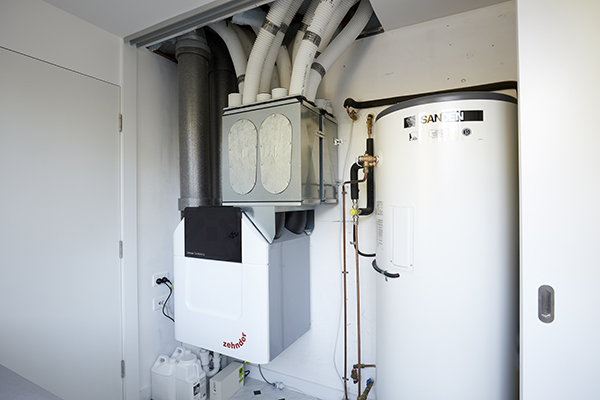Just How Heat Recovery Ventilation Improves Indoor Air Top Quality and Reduces Energy Costs
Heat Recovery Ventilation (HRV) systems play a vital role in boosting indoor air top quality while at the same time reducing power expenses. By effectively trading stagnant indoor air with fresh outdoor air, HRVs help keep perfect humidity and minimize contaminants. In addition, their capability to recoup warm from outward bound air lessens the pressure on heating and cooling down systems. As energy prices remain to rise, comprehending the full potential of HRV systems ends up being significantly important for property owners and organizations alike.
Recognizing Heat Recovery Ventilation Systems

Heat recovery ventilation (HRV) systems play an essential duty in enhancing indoor air high quality, especially in modern, energy-efficient structures. These systems are created to transfer warmth from the outward bound stale air to the inbound fresh air, thereby decreasing power loss while preserving perfect temperature level degrees inside. HRVs contain a warm exchanger, fans, and ductwork, assisting in the continuous blood circulation of air. By expelling interior toxins and introducing fresh air, HRVs assist to balance moisture degrees, prevent mold development, and decrease allergens. The efficiency of HRV systems hinges on their capability to recuperate up to 80% of the heat from the exhausted air, promoting energy conservation while making certain a healthy and balanced indoor setting. Their assimilation is important in achieving sustainable living techniques.
The Importance of Indoor Air Quality
Indoor air quality (IAQ) is an essential factor influencing the health and wellness of passengers in any type of atmosphere. Poor IAQ can cause numerous health and wellness concerns, consisting of breathing issues, allergic reactions, and fatigue. Additionally, it can aggravate current conditions such as asthma. Factors contributing to reduced IAQ include pollutants from interior sources like cleaning up representatives, mold, and inadequate ventilation. As a result, preserving excellent IAQ is essential for advertising a secure and comfy living or working area. Effective methods to boost IAQ involve normal tracking of air high quality, appropriate air flow systems, and minimizing making use of hazardous materials indoors. By focusing on IAQ, people can guarantee a much healthier atmosphere that cultivates productivity and total lifestyle.
Energy Effectiveness Conveniences of HRV Systems
Several property owners and structure supervisors are increasingly identifying the energy effectiveness advantages of heat healing air flow (HRV) systems. By transferring warm from tired indoor air to inbound fresh air, HRV systems markedly lower the power required for heating and cooling. This procedure reduces reliance on standard cooling and heating systems, bring about lower power expenses. Furthermore, HRVs aid maintain a well balanced interior climate, avoiding too much heating or cooling demands. The capacity to recoup approximately 90% of the warm from outgoing air additionally supports sustainability efforts by decreasing total power consumption. HRV systems contribute not only to cost savings yet also to a decreased carbon footprint, lining up with the expanding focus on energy-efficient building methods.
Installment and Maintenance Considerations
The effective execution of warm recovery air flow (HRV) systems calls for mindful consideration of installation and upkeep elements to ensure peak performance. Proper positioning of the HRV system is crucial, as it must be installed in an area that takes full advantage of airflow while reducing noise disruption. Furthermore, ductwork has to be appropriately sized and protected to avoid power loss. Regular upkeep, consisting of filter substitute and system cleansing, is critical to protect ideal performance and interior air high quality. Owners should establish a routine see this website maintenance schedule to identify and address potential issues before they intensify. Cooperation with seasoned experts throughout both installation and maintenance phases can improve the durability and performance of HRV systems, eventually leading to much better indoor settings and reduced energy costs.
Real-World Applications and Success Stories
Checking out real-world applications of heat recuperation ventilation (HRV) systems discloses their considerable effect on indoor air top quality and power efficiency throughout various settings. In residential buildings, property owners have actually reported enhanced air top quality, resulting in less allergic reactions and breathing issues. Schools implementing HRV systems have actually kept in mind boosted student concentration and reduced absence due to better ventilation. Commercial buildings, such as workplaces and retail areas, have actually experienced reduced power costs and raised staff member efficiency. For example, a company office in a temperate climate accomplished a 30% decrease in energy expenses after mounting an HRV system. These success tales show that HRV modern technology not just contributes to much healthier settings but additionally provides concrete financial advantages, making it a valuable investment for different sectors.
Often Asked Questions
Can HRV Systems Minimize Irritants in Indoor Air?
The effectiveness of HRV systems in lowering indoor irritants mostly rests on their capability to filter and exchange air. HRV Heat Recovery Ventilation. By constantly replacing stale air, these systems can significantly lower irritant degrees throughout indoor settings

Just How Does Humidity Affect HRV System Performance?
Moisture considerably influences HRV system efficiency; high levels can great post to read result in condensation, decreasing performance, while low moisture may improve air exchange. Stabilizing moisture is crucial for suitable procedure and preserving interior air quality.
Are HRV Systems Noisy During Procedure?
HRV systems can create differing noise degrees throughout procedure, depending on their style and setup. Some systems run quietly, while others may create noticeable audio, particularly at higher air movement setups or when inadequately preserved.
What Is the Ordinary Life Expectancy of an HRV System?

Can HRV Equipments Be Used in All Environments?
HRV systems can be made use of in various environments, but their efficiency might vary - HRV Heat Recovery Ventilation. In extreme temperature levels, modifications or supplemental systems might be required to guarantee suitable performance and comfort while preserving interior air top quality